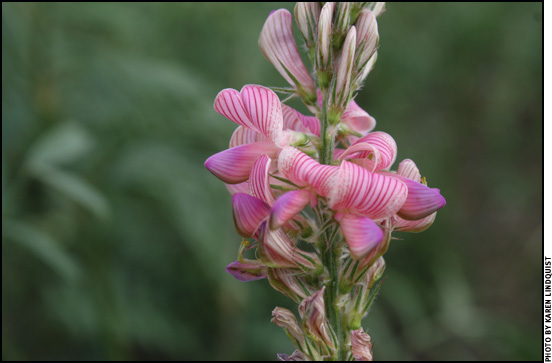HEALTH & NUTRITION...

Sainfoin Causes Less Risk for Bloat
Legumes are beneficial in pastures because they contain more protein and minerals than grasses, but some legumes carry risk for bloat.
While there are many benefits to legumes in terms of nutrition and soil health, they also carry risk for bloat. A legume under study lately for livestock forage is sainfoin. Andrea Hanson, beef extension specialist for Alberta Agriculture and Forestry, has been working with managers, producers, and 11 applied research and extension associations across Alberta on a two-year study called the High Legume Pasture Project.
The first year was establishing sainfoin as part of a high-legume pasture mix at 12 sites across Alberta, and the second year looked at grazing those sites. Some producer cooperators had very good establishment on the first year, while others did not — either because of too much or too little moisture, weeds or some other reasons, she says. Read more.
Hauling After Breeding is Risky
Cattle that are transported a few days after being bred may be at risk for losing the pregnancy.
Some folks who artificially inseminate (AI) their cows or heifers haul them to summer pasture or another location after being bred. It’s important to avoid transport stress during that first week, if possible.
Keith Elkington, a breeder near Idaho Falls, Idaho, says he’s learned to pay attention to timing of hauling.
“We usually synchronize our yearling heifers and breed them AI,” says Elkington. “Studies have shown that if you are going to move them afterward and take them to summer pasture, the best time to move them is in the first 24 hours, or to wait a few weeks.” Read more.
Silage Safety
Beware of mycotoxins even without visible mold.
In many cases, mycotoxins won’t alert livestock producers to their presence. There may be no visible mold and no bad smell. Yet, the infestation can be there — waiting to drag down production, decrease herd health, lower fertility and even be a food safety hazard.
“While mycotoxins are produced by specific molds, visible signs of mold may not translate to measurable mycotoxin levels and vice versa,” says Renato Schmidt, Technical Services — Silage, Lallemand Animal Nutrition. “It’s virtually impossible to completely avoid mycotoxin exposure. The toxins can be produced both on the growing crop and during storage and feedout.” Read more.
Cut Costs by Cutting BRD Re-treats
When it comes to bovine respiratory disease treatments, it’s usually either do it right or do it twice.
Pull. Re-treat. Pull. Re-treat. Does this sound like an all-too-familiar process treating bovine respiratory disease (BRD)?
While it’s impossible to completely eliminate pulls and repeat BRD treatments, with good management, a strong veterinary relationship and a more effective antibiotic to treat BRD when needed, you can help reduce some re-treats and the expenses that come with them. Read more.
Tick Season Starts
Tick season has officially started, increasing the risk of Lyme disease and anaplasmosis.
The weather’s finally warm. The sun is out — and so are the ticks.
This year, tick season in Ohio is expected to be pretty bad, says Glen Needham, a retired entomologist and tick expert formerly with Ohio State University (OSU) Extension, the outreach arm of the College of Food, Agricultural and Environmental Sciences (CFAES) at OSU.
Already Needham has collected the first black-legged or deer-tick nymph of the season in Coshocton County. It’s just the beginning of what people can expect to see as tick season ramps up, he says. Read more.
Avoid Extra Heats Due to Heat
How to keep your cows bred through the heat of summer.
Cattle producers go to great lengths to do whatever it takes to get their cows bred. What about after they are bred? Keeping a cow bred, especially during the summer months, can be equally as challenging.
Typically, if a fertile bull breeds cows at the correct time, fertilization rates should reach nearly 100%. However, normal single-service conception rates run anywhere from 60% to 80%. The 20%-40% difference must come from embryonic or fetal loss. Loss of pregnancy can result in longer calving windows, lower weaning weights and less profitability for producers.
Oklahoma State University conducted some of the first research on the implications of heat stress on pregnancy rates. Read more.
Cattle Diseases: Common Conditions/Terms
Click here for a list of common conditions and terms related to beef cattle diseases, such as anaplasmosis, brucellosis, BVD, E. coli, IBR and others.
[Click here to go to the top of the page.]






